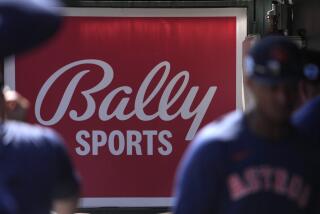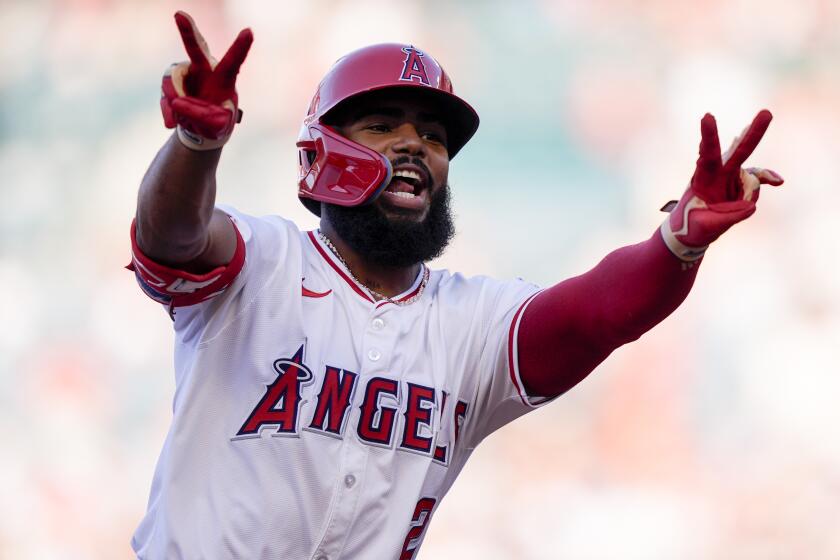Local Fans Could Be Biggest Losers
- Share via
Can you imagine what it would be like if the Angels and Dodgers met in the World Series this October?
The Angels would actually appear on television ... live television. Dodger Stadium would be filled with fans ... by the first inning. Local sports anchors would probably trip all over themselves trying to find their way to Edison Field ... because most of them have never been there.
And what about the buzz around Southern California, the excitement a Freeway World Series would create? Rex Hudler, the Angel broadcaster, would be so emotionally charged, so bursting with enthusiasm, he might just go the route of that drummer in “This is Spinal Tap,” the guy who just ... blew up.
“That would be so cool for us, for the Angels, for the community,” Dodger veteran utility player Dave Hansen said of a potential Freeway World Series, not the possibility of Hudler spontaneously combusting.
“When the Mets and Yankees made it [to the World Series in 2000], it was really special for New York, and it would be the same way here. The whole community would be proud of both teams, it would be something everyone talked about, it would pull us all together.... It would be awesome.”
It will have no chance of happening if a strike wipes out the rest of this season and the postseason, as the 1994 strike did.
Fans--and, yes, even most players--in such cities as Atlanta, Phoenix, Minneapolis and New York will be furious if a work stoppage, scheduled to begin Friday if a collective bargaining agreement can’t be reached, forces cancellation of the playoffs and World Series.
But perhaps no part of the country has more to lose in a strike than Southern California.
The Dodgers, who have not won a playoff game since 1988, and the Angels, who have not reached the playoffs since 1986, have never made the playoffs in the same year--rare is the season in which both teams even contend for division titles--but 2002 appears to be an exception.
After their franchise-worst 6-14 start in April, the Angels went on a torrid 31-10 run from April 24 to June 10, establishing themselves as a legitimate playoff threat.
They have more pitching depth than those Angel teams that collapsed in 1995 and fizzled in September of 1997 and ‘98, and their offense is so balanced they don’t have to lean too heavily on one or two players.
The Angels are 78-54 after Wednesday night’s loss to Tampa Bay, four games behind Oakland in the American League West and a half-game ahead of Seattle in the AL wild-card race, and though September, the black-hole month in franchise history, is around the corner, this Angel team has shown few signs of cracking.
The Dodgers have shown a similar resilience. They had a 2 1/2-game lead over Arizona in the National League West at the All-Star break before going 8-17 to start the second half and falling seven games behind the Diamondbacks.
But they recovered from that four-week skid with 15 wins in their next 20 games and are 77-56 after Wednesday night’s 1-0 victory over Arizona. They are 2 1/2 games ahead of San Francisco in the NL wild-card race.
Starting pitchers Hideo Nomo, Andy Ashby, Odalis Perez and Omar Daal have been brilliant in August, the offensively challenged Dodgers have developed a knack for coming up with clutch hits, and the dominance of closer Eric Gagne has been the primary reason they are 24-11 in one-run games.
Good starting pitching, timely hitting, a reliable closer ... the Angels and Dodgers seem to have many of the ingredients required to make an October run--if there is an October track to run on, that is.
“This team has shown everyone we are good enough to go to the World Series and win the World Series,” Perez said. “A strike for us right now would be devastating. We don’t need that.”
Not since 1995 have the Dodgers and Angels rumbled down such parallel playoff tracks. That was the year the Dodgers won the NL West and the Angels lost a one-game playoff to Seattle to determine the AL West champion.
But there was little hype for a potential Freeway World Series that year because the focus in the final two months of the season was on the Angels’ horrendous collapse, when they blew an 11-game division lead in August and September.
Only two other times since the Angels were born in 1961 have the Angels and Dodgers stirred hopes of a possible Freeway World Series.
The Dodgers won the NL West with a 95-67 record in 1985, and the Angels went 90-72 but finished a game behind Kansas City in the AL West.
The Angels won the AL West in 1982, but the Dodgers finished a game behind Atlanta in the NL West when Joe Morgan hit a game-winning homer off Terry Forster to help the San Francisco Giants defeat the Dodgers on the final day of the regular season.
“The magic of the summer is the fact that this thing is a marathon,” Angel Manager Mike Scioscia said. “The magic of a pennant race is seeing it to fruition. We’re seeing the early birth of a pennant race. To miss out on it because of a work stoppage would be terrible.”
Tim Mead, Angel vice president of communications, is one of only a handful of team officials who were around in 1986, when the Angels were one strike away from the World Series when Dave Henderson hit that fateful homer off Donnie Moore in the ninth inning of Game 5 of the AL championship series.
The Red Sox won, 7-6, in extra innings, returned to Boston to win Games 6 and 7, and the Angels still haven’t made it to the World Series.
“There are folks in the organization who believe there is still some unfinished business here, for Gene Autry and Jimmie Reese and some other good people,” Mead said, referring to the Angels’ late owner and late coach. “To be so close and not get a chance to complete that would probably bother me more than anything.”
Angel first baseman Scott Spiezio can’t stand the thought of a season like this “going down the drain,” and he acknowledged he’d be “crushed” if players went on strike.
But he, like every big leaguer, has put his faith in union chief Don Fehr, and if no labor agreement is reached, Spiezio and the rest of the Angels and Dodgers will walk Friday--even if that means Southern California’s most promising baseball season in years, and a potential Freeway World Series, go up in smoke.
“It’s hard to be a baseball player and concentrate on winning games and getting to the playoffs and World Series and also keep up with the intrigue of these negotiations,” Spiezio said. “It’s gigantic. It’s mind-boggling, all the stuff you’d have to read. I just have to trust the people who have been doing this for 25 years.
“It reminds me of when I was in high school and I really wanted to play football, but my dad said I couldn’t play. He could see I had a future in baseball and didn’t want me to risk injury. Sometimes you just have to trust the advice of people you trust.”
*
(BEGIN TEXT OF INFOBOX)
Strike a Deal
*
Key issues that led to the previous eight work stoppages in Major League Baseball and how long each lasted:
*--* Year Stoppage Days Gms Key Issues 1972 Strike 14 86 player pensions, binding arbitration Work stoppage lasted from April 1-12 1973 Lockout 12 0 Salary arbitration Lasted from Feb. 8-25 1976 Lockout 17 0 free agency, re-entry draft Lasted from March 1-17 1980 Strike 8 0 free-agent compensation Lasted from April 1-8 1981 Strike 50 712 free-agent compensation Lasted from June 12-July 31 1985 Strike 2 0 Salary arbitration Lasted from Aug. 6-7 1990 Lockout 32 0 salary arbitration and salary cap Lasted from Feb. 15-March 18 1994-95 Strike 232 938 salary cap and revenue sharing Lasted from Aug. 12-March 31
*--*
*
Salary Hike
Average salaries
since 1971:
1971...$31,543
1972...$34,092
1973...$36,566
1974...$40,839
1975...$44,676
1976...$51,501
1977...$76,066
1978...$99,876
1979...$113,558
1980...$143,756
1981...$185,651
1982...$241,497
1983...$289,194
1984...$329,408
1985...$371,571
1986...$412,520
1987...$414,454
1988...$438,729
1989...$497,254
1990...$597,537
1991...$851,492
1992...$1,028,667
1993...$1,076,089
1994...$1,168,263
1995...$1,110,766
1996...$1,119,981
1997...$1,336.609
1998...$1,398,831
1999...$1,720,050
2000...$1,895,650
2001...$2,198,312
2002...$2,380,106
*
Fan Support
A look at average attendance each season since the first work stoppage in 1972:
1971...15,017
1972*...14,592
1973*...15,488
1974...15,445
1975...15,324
1976*...16,110
1977...18,381
1978...19,296
1979...20,679
1980*...20,425
1981*...18,906
1982...21,172
1983...21,624
1984...21,245
1985*...22,234
1986...22,558
1987...24,697
1988...25,166
1989...26,199
1990*...26,032
1991...26,977
1992...26,530
1993...30,977
1994*...31,335
1995*...25,034
1996...26,498
1997...27,852
1998...28,946
1999...28,864
2000...29,938
2001...29,802
2002...28,602
*-labor stoppage
Researched by Houston Mitchell
More to Read
Go beyond the scoreboard
Get the latest on L.A.'s teams in the daily Sports Report newsletter.
You may occasionally receive promotional content from the Los Angeles Times.







